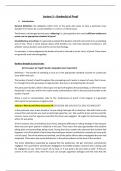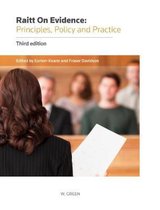Lecture 3 – Burden(s) of Proof
1. Introduction:
General definition: the obligation which rests on the party who seeks to have a particular issue
decided in his favour by a court (whether in a civil or a criminal case).
The Burden is discharged by that party ‘adducing’(i.e. placing before the court) sufficient evidence to
prove case to appropriate standard of proof.
Unsatisfactory area of law: It is generally accepted that burdens of proof is/are a bit of an unsatisfying
area of law. There is some dispute about what burdens are, how they operate (‘incidence’), and
whether various burdens exist and the correct terminology.
For example, in some judgments the burden of proof is referred to as the ‘onus’ of proof. These terms
are generally used interchangeably.
Burdens thought to exist in law:
(i) Persuasive (or ‘legal’) burden (arguably most important):
Definition – ‘the burden of satisfying a court as to the appropriate standard of proof on a particular
issue within the case’.
The burden of proof is fixed throughout the proceedings and it exists in respect of every fact in issue.
It is thought to be the persuasive or legal burden, the main or principal burden of proof.
This persuasive burden, which is fixed upon one party throughout the proceedings, is referred to most
frequently in case law, and for this reason many commentators refer to the persuasive burden as the
burden of proof.
When a court or commentators refer to ‘the burden/onus of proof’ in the singular, it is generally
referring to the persuasive or legal burden.
Jackson v Murray and Aviva Insurance UK [2012] CSIH 100; 2013 SLT153; 2015 SC (UKSC) 105*
In this particular case, it was actually a 13-year-old girl who got off a school bus. She didn't look as she
crossed the road and she was stuck at quite high speed by a car. She sued the driver and she sued the
insurers, Aviva, and her argument was that the driver was negligent. He ought to have been looking
where he was going.
At first instance, the Lord Ordinary (Lord Tyre), had great difficulty in making findings in fact because
there was such poor quality in evidence in the case. There was a five-year gap between the accident
taking place and proceedings being raised. During that time, people who observed the accident had
forgotten a lot of the detail of what they observed (poor witness recollection is actually an issue quite
a lot of cases). One of the witnesses had died, one of the police officers who investigated the case had
emigrated. There were also some deficiencies in the police evidence at the time of the accident.
The driver (defender) responded by arguing that the pedestrian, the girl, had been contributorily
negligent. The Law Reform Contributory Negligence Act (1945) enables someone who is being sued
for negligence to say, "well, it wasn't all my fault, or it was quite a bit your fault as well". If they are
correct in the court's view, then the court can actually apportion damages and find only that the
, pursuer should get a certain percentage of what they're actually seeking or what they award they're
given is.
The key facts in issue related to persuasive (legal) burdens – whose fault the accident was, to who was
liable ultimately as a matter of law.
The Pursuers Persuasive Burden was to prove driver negligent/responsible in law for the injury.
The Defenders Persuasive Burden was to prove the Pursuer was contributorily negligent to her own
injuries.
The Lord Ordinary found that the “overwhelmingly greater cause of the accident had been the
pursuer’s movements into the path of the defender’s vehicle” (para 47)
A finding of 90% contributory negligence was appropriate – eventually reduced to 50/50 by Supreme
Court.
(ii) Evidential burden:
Definition – the burden of adducing [providing] enough evidence on a particular issue to warrant the
court considering that issue at all.
Jackson v Murray and Aviva Insurances UK
The evidential burden on the pursuer was discharged by lodging certain pieces of evidence at the
outset:
- She lodged Police Incident Reports which is documentary evidence.
- She had witnesses give oral evidence on her behalf.
- She also instructed expert testimony (expert opinion evidence) about driving speeds, reaction
time etc.
In so doing, she had discharged the evidential burden, the burden of just giving the court enough
evidence to realise that this is a case that merits being determined by a court.
(iii) Tactical (or ‘provisional’, or ‘shifting’) burden:
Definition – irrespective of where the persuasive or evidential burdens lie there is a ‘tactical’, or
‘shifting’, burden placed upon B, once A has given evidence of her position, to give some evidence of
his position. This is known as the Tactical burden of Proof. It operates irrespective of where the
persuasive and evidential burdens lie.
E.g. Criminal Cases: the burden is always on the Crown to prove guilt. The accused never has to prove
his or her innocence. That would be the legal and/or persuasive burden on the crown.
However, there is a school of thought that suggests there's an overlying tactical burden. a silent
defender should really think carefully before remaining silent. It's generally better to put your
argument in front of the court to bat the ball back into your opponent's court.
In Civil cases, like Jackson v Murray, the defender tactically responded to the pursuers claim by
producing his own evidence. He had produced an expert report which didn't agree with the expert
report that the pursuer had provided, and he also gave evidence himself.





